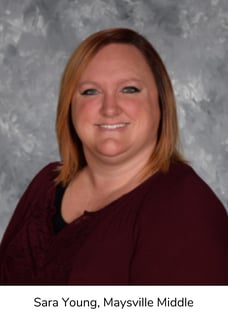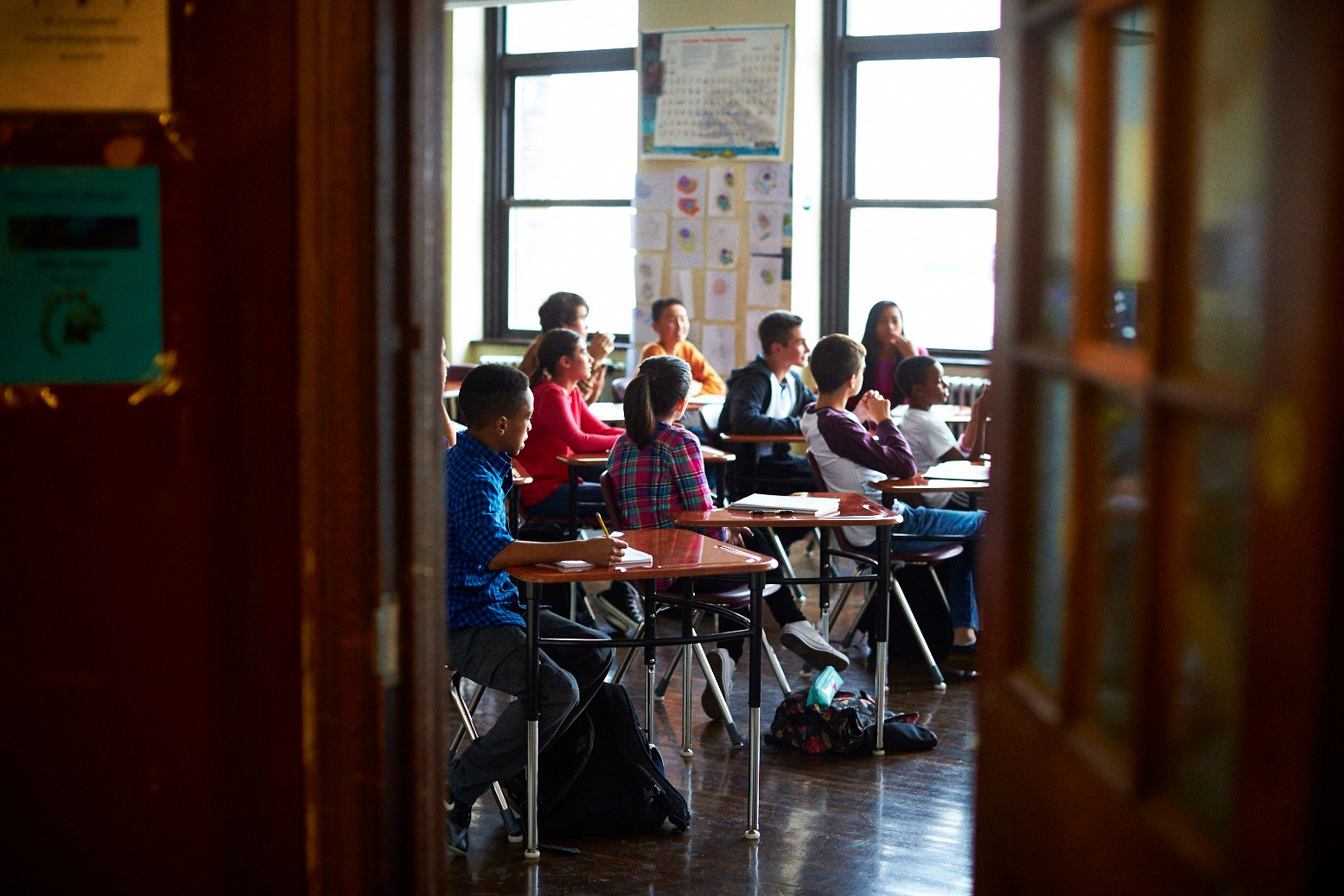Posted in: Aha! Blog > Wit & Wisdom Blog > Implementation Support > Read, Repeat, Reveal
In this third installment of a five-part blog series, Great Minds® teacher-writer Emily Gula connects with students and teachers around the country to learn about their successes using Wit & Wisdom® in their English classrooms.
Wit & Wisdom lessons explore five Content Framing Questions. The Content Framing Questions are key questions that lead students through a series of five stages of reading called Content Stages: Wonder, Organize, Reveal, Distill, and Know. Each of these stages builds an important habit of mind to help students closely read complex text.

Although a century separates the experiences of World War I soldiers from today’s youth, students in Sara Young’s eighth-grade language arts class at Maysville Middle School have deep knowledge of the experiences of soldiers in World War I. Maysville eighth-graders engaged in study of the Wit & Wisdom module The Great War, which is centered around All Quiet on the Western Front by Erich Maria Remarque.
I had a conversation with Sara Young and her principal, Erik Winland. They shared how Wit & Wisdom’s third Content Stage, Reveal, deepened students’ understanding of this challenging World War I novel and its powerful history.
DIGGING DEEP
The Reveal Content Stage guides students to delve deeper into the gold of a text through targeted analysis. By closely reading shorter sections of text and focusing on one specific element, students develop a better understanding of the text as a whole. The Reveal is flexible: students explore what is most distinctive about any given text. Reveal questions might probe word choice, literary devices, text structure, illustrations, and many other elements.
Winland observes how the multifaceted Reveal stage has changed how his students learn: “I see fresh things they are doing every day…I see it as a principal and as a parent. I hear kids talking about language arts class. Kids are excited to go there.”
In a lesson focusing on Chapter 9 of All Quiet on the Western Front, students in Young’s class examined comradeship among the characters as they explored one Reveal lesson’s Content Framing Question: “What does a deeper exploration of the incident in the shell-hole reveal?” Through closely studying this scene, students gathered evidence to discuss the main character’s attitude towards his comrades, and gained a greater awareness of the war’s effects on soldiers. Young highlighted how focusing on one line in Chapter 9 made an impression on students. The main character, Paul, describes his fellow soldiers in this way: “They are more to me than life, these voices, they are more than motherliness and more than fear; they are the strongest, most comforting thing there is anywhere: they are the voices of my comrades” (Remarque 212). After analyzing this quote, Young’s students explained that for Paul, his comrades “were his everything.”
By digging deeply into a single line, students discovered how one sentence could illuminate a theme running through the entire text: war profoundly affects individuals as well as society at large. In an earlier Reveal lesson, students explored trench warfare from another angle by studying descriptive details. Students chose one piece of textual evidence that best conveyed how trench warfare affected Paul and explained what made the paragraph’s description powerful. Students shared, “Paul has changed, along with the world around him” and “He learned that since the war, things will never be normal again.”
ANALYZING ART
While many Reveal lessons revolve around close reads of literary and informational texts, students in Wit & Wisdom classrooms also closely read works of art that further build knowledge about the module topic. While studying The Great War, Young’s students examined the cubist painting Soldiers Playing Cards by Fernand Léger. Young observed how her students learned to closely study a piece of art, just as they would analyze a written text. After examining how the artist used geometric shapes to depict the soldiers, students discussed what the artist’s choices could reveal about attitudes towards warfare. Students shared how the soldiers “were almost like robots…or machines.” Young says, “I was amazed by how much they were able to pull out from that painting.” Zooming in on certain features provided evidence to support students’ recognition of the implicit meaning of the painting as well as the module topic.
PERSISTENCE PAYS OFF
 Exploring distinct elements within one painting or story demonstrates the depth of knowledge that one text or work of art can offer. Reveal lessons help students mine the gold of texts and encourage them to dig deeper with each new reading. Young explains how Reveal lessons highlight the importance of multiple reads. “Rereading has become so important…[Students] can…focus on different parts in the book … like going back to personification or looking at a soldier’s perspective.”
Exploring distinct elements within one painting or story demonstrates the depth of knowledge that one text or work of art can offer. Reveal lessons help students mine the gold of texts and encourage them to dig deeper with each new reading. Young explains how Reveal lessons highlight the importance of multiple reads. “Rereading has become so important…[Students] can…focus on different parts in the book … like going back to personification or looking at a soldier’s perspective.”
Wit & Wisdom lessons reveal the possibilities within a text and the more nuanced understandings that students are capable of unpacking. The Reveal stage provides a scaffold for students by elevating certain elements of the text that more experienced readers may naturally notice. Through exploring a diverse range of text elements, students analyze how each affects the meaning of the text overall.
 Winland describes how the Reveal stage can be challenging, but rewarding: “It expands the minds of our language arts kids…When it gets tough, because it will get tough…expect that the kids can do the work…Don’t deviate from the program because a kid is struggling. Keep pushing him and don’t give up on him.” Taking time to deeply explore a text is worth the effort. The Reveal stage creates new entry points for students to explore texts with deeper understanding, and prepares them to discover the essential meaning of a text in the next Content Stage—the Distill stage.
Winland describes how the Reveal stage can be challenging, but rewarding: “It expands the minds of our language arts kids…When it gets tough, because it will get tough…expect that the kids can do the work…Don’t deviate from the program because a kid is struggling. Keep pushing him and don’t give up on him.” Taking time to deeply explore a text is worth the effort. The Reveal stage creates new entry points for students to explore texts with deeper understanding, and prepares them to discover the essential meaning of a text in the next Content Stage—the Distill stage.
Through their study of The Great War module, Young’s class went beyond an introduction to the World War I era and gained a richer understanding of the experiences of individual soldiers and the war’s lasting effects. Young explains, “Students were shocked when it was put into context of how close in age they were [to the soldiers]…They found all of that enlightening.”
Works Cited
Léger, Fernand. La Partie de Cartes. 1917. Kröller-Müller Museum, Otterlo, Netherlands. Kröller Müller, Web. Accessed 1 July 2016.
Remarque, Erich Maria. All Quiet on the Western Front. Translated by A.W. Wheen, 1929, Ballantine Books, 1982.
Submit the Form to Print

Emily Gula
Emily Gula is a content lead at Great Minds, where she led a team of teacher-writers in creating the first-grade modules of Wit & Wisdom. Emily began her career teaching elementary school in New Orleans, then worked in New Orleans schools as a reading interventionist and literacy coach.
Topics: Implementation Support











